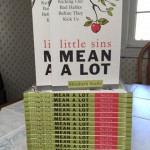C’mon, now…that’s a provocative cover. The title, daring to use the deplorable label that has been flung about rather-too-freely in the past few years; the cover, the classic “happy-face” – ubiquitous in the early 1970’s and plastered everywhere as societal conventions came tumbling down. Just past Haight-Ashbury and the Generation Gap, in the middle of the “unisex everything” years of protest and upheaval, everywhere you looked that simple yellow face floated before you and said “be happy!” The cover is brilliant.
Haven’t read a word of it, of course, but I’ve suspected Jonah Goldberg had this book in him since ‘way back when he wrote this column in 2001 and this one in 2002
I’ve noticed that the “Nazi” flinging – which was nearly out of control a few years ago has decreased, and that’s a good thing. Probably that means it is a very good time for someone like Goldberg – who has made a point of reminding his readers that “Nazi” comes from National Socialist and that disagreements and differences in opinion do not a nazi make – to release this into the marketplace of ideas and (hopefully) encourage an adult discussion about what nazi-ism is, how it came into being, and where some of its tenets may be found in 21st century America and abroad.
I gather – from the reviews – that Goldberg (who points out in this column that Vladimir Putin takes a page from FDR) is doing more, here. A few review excerpts:
Goldberg sees the fascist exaltation of youth, glorification of violence, hatred of tradition and romance of “the street” in the New Left of the 1960s, still the subject of the fond memories for the liberal establishment in this country. Goldberg argues that “liberal fascism” — the phrase was coined by H. G. Wells, and he meant it positively — is a distant heir to European fascism. The liberal version is pacifist rather than militaristic and feminine rather than masculine in its orientation, but it also seeks to increase the power of the state and overcome tradition in sweeping crusades pursued with the moral fervor of war.
When Mr. Goldberg uses the term “liberal fascism,” he is not offering a right-wing version of the left’s smears. He knows it is a loaded term. What he is talking about is the historical idea of fascism: a corporatist and statist social structure that creates a deep reliance of its subjects on the government and engenders a sense of community and purpose. In American politics, this tendency toward statism has always been much more at home on the left than on the right.
It is impossible in a short review to do justice to the rich intellectual history of American liberalism that Mr. Goldberg offers to his readers. He has read widely and thoroughly, not only in the primary sources of fascism, but in the political and intellectual history written by the major historians of the subject.
Readers will learn that the very term “liberal fascism” came from the pen of H.G. Wells, the famed socialist author who delivered a speech at Oxford University in 1932 that included hosannas to both Stalin’s Russia and Hitler’s Germany. “I am asking,” Wells told the students, “for a Liberal Fascisti, for enlightened Nazis.” Democracy, he argued, had to be replaced with new forms of government that would save mankind, producing a “‘Phoenix Rebirth’ of liberalism” that would be called “Liberal Fascism.” Like the activism, experimentation, and discipline that made the Soviet Union and Nazi Germany new dynamic societies, the West too could reach such a plateau by adopting the new soft fascism that suited it best.
Here’s hoping that Goldberg has the good fortune to be able to discuss his book with real back-and-forth in the coming weeks. I know that for some on the left there will be no need to open the pages of the book – the very fact that Goldberg has used that title, and that cover image, will be enough for a thousand breathless denunciations of the author as “the real Nazi, the Nazi apologist” or whatever. And some on the right may think they needn’t read it, either, but they probably should.
For thoughtful folks on both sides of the aisle, this book may be a useful opening to begin once again listening to each other instead of simply shouting down. If right and left can finally come to a point where both sides may look upon this one word and agree on its meaning, then maybe there will be another word down the road about which there may be mutual recognition, and then maybe another and another. Soon, maybe left and right may be able to dialogue on the meaning of whole sentences, in a peacable and enlightening way. Perhaps peace is built in such ways. Wouldn’t it be loverly?
So, good luck to Goldberg – he’s taking on a brave task – and my copies should be on their way as I write this!
As usual, a percentage of monies earned from anything you purchase at Amazon via this site is donated to the hospice that helped my brother and our family through his last weeks, and I thank you.











